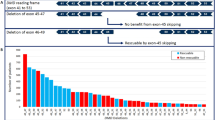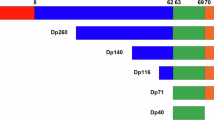Abstract
Deletion of exons 45–55 (del45–55) in the Duchenne muscular dystrophy gene (DMD) has gained particular interest in the field of molecular therapy, because it causes a milder phenotype than DMD, and therefore, may represent a good candidate for the goal of a multiple exon-skipping strategy. We have precisely characterized deletion breakpoints in three patients with del45–55 in DMD. Two of them were young adult males of the X-linked dilated cardiomyopathy phenotype, and the third patient revealed the mild Becker muscular dystrophy phenotype of late onset. The deletion breakpoints differed among patients. The deletion started at nt 226 604, 231 518, 117 284 in intron 44, and ended at nt 64 994, 59 314, 71 806 in intron 55, respectively. Deletion junctions showed no significant homology between the sequences adjacent to the distal and proximal end joints in these patients. Deletion breakpoints were not primarily associated with any particular sequence element, or with a matrix attachment region. However, there were several palindromic sequences and short tandem repeats at or near the breakpoints. These sequences, with a marked propensity to form secondary DNA structure intermediates, may predispose local DNA to breakage and intragenic recombination in these patients.
Similar content being viewed by others
Log in or create a free account to read this content
Gain free access to this article, as well as selected content from this journal and more on nature.com
or
References
Muntoni, F., Torelli, S. & Ferlini, A. Dystrophin and mutations: one gene, several proteins, multiple phenotypes. Lancet Neurol. 2, 731–740 (2003).
Forrest, S. M., Cross, G. S., Speer, A., Gardner-Medwin, D., Burn, J. & Davies, K. E. Preferential deletion of exons in Duchenne and Becker muscular dystrophies. Nature 329, 638–640 (1987).
Koenig, M., Hoffman, E. P., Bertelson, C. J., Monaco, A. P., Feener, C. & Kunkel, L. M. Cloning of the Duchenne muscular dystrophy (DMD) cDNA and preliminary genomic organization of the DMD gene in normal and affected individuals. Cell 50, 509–517 (1987).
Koenig, M., Beggs, A. H., Moyer, M., Scherpf, S., Heindrich, K., Bettecken, T. et al. The molecular basis for Duchenne versus Becker muscular dystrophy: correlation of severity with type of deletion. Am. J. Hum. Genet. 45, 498–506 (1989).
den Dunnen, J. T., Grootscholten, P. M., Bakker, E., Blonden, L. A., Ginjaar, H. B., Wapenaar, M. C. et al. Topography of the Duchenne muscular dystrophy (DMD) gene: FIGE and cDNA analysis of 194 cases reveals 115 deletions and 13 duplications. Am. J. Hum. Genet. 45, 835–847 (1989).
Blonden, L. A., Grootscholten, P. M., den Dunnen, J. T., Bakker, E., Abbs, S., Bobrow, M. et al. 242 breakpoints in the 200-kb deletion-prone P20 region of the DMD gene are widely spread. Genomics 10, 631–639 (1991).
Oudet, C., Hanauer, A., Clemens, P., Caskey, T. & Mandel, J. L. Two hot spots of recombination in the DMD gene correlate with the deletion prone regions. Hum. Mol. Genet. 1, 599–603 (1992).
Béroud, C., Tuffery-Giraud, S., Matsuo, M., Hamroun, D., Humbertclaude, V., Monnier, N. et al. Multiexon skipping leading to an artificial DMD protein lacking amino acids from exons 45 through 55 could rescue up to 63% of patients with Duchenne muscular dystrophy. Hum. Mutat. 28, 196–202 (2007).
Nakamura, A., Yoshida, K., Fukushima, K., Ueda, H., Urasawa, N., Koyama, J. et al. Follow-up of three patients with a large deletion of exons 45–55 in the Duchenne muscular dystrophy (DMD) gene. J. Clin. Neurosci. 15, 757–763 (2008).
Tasaki, N., Yoshida, K., Haruta, S., Kouno, H., Ichinose, H., Fujimoto, Y. et al. X-linked dilated cardiomyopathy with a large hot-spot deletion in the dystrophin gene. Intern. Med. 40, 1215–1221 (2001).
Yazaki, M., Yoshida, K., Nakamura, A., Koyama, J., Nanba, T., Ohori, N. et al. Clinical characteristics of aged Becker muscular dystrophy patients with onset after 30 years. Eur. Neurol. 42, 145–149 (1999).
Love, D. R., England, S. B., Speer, A., Marsden, R. F., Bloomfield, J. F., Roche, A. L. et al. Sequences of junction fragments in the deletion-prone region of the dystrophin gene. Genomics 10, 57–67 (1991).
Sironi, M., Pozzoli, U., Cagliani, R., Giorda, R., Comi, G. P., Bardoni, A. et al. Relevance of sequence and structure elements for deletion events in the dystrophin gene major hot-spot. Hum. Genet. 112, 272–288 (2003).
Toffolatti, L., Cardazzo, B., Nobile, C., Danieli, G. A., Gualandi, F., Muntoni, F. et al. Investigating the mechanism of chromosomal deletion: characterization of 39 deletion breakpoints in introns 47 and 48 of the human dystrophin gene. Genomics 80, 523–530 (2002).
Byers, T. J., Lidov, H. G. W. & Kunkel, L. M. An alternative dystrophin transcript specific to peripheral nerve. Nat. Genet. 4, 77–81 (1993).
Lidov, H. G. W., Selig, S. & Kunkel, L. M. Dp140: a novel 140 kDa CNS transcript from the dystrophin locus. Hum. Mol. Genet. 4, 329–335 (1995).
McNaughton, J. C., Cockburn, D. J., Hughes, G., Jones, W. A., Laing, N. G., Ray, P. N. et al. Is gene deletion in eukaryotes sequence-dependent? A study of nine deletion junctions and nineteen other deletion breakpoints in intron 7 of the human dystrophin gene. Gene 222, 41–51 (1998).
Suminaga, R., Takeshima, Y., Yasuda, K., Shiga, N., Nakamura, H. & Matsuo, M. Non-homologous recombination between Alu and LINE-1 repeats caused a 430-kb deletion in the dystrophin gene: a novel source of genomic instability. J. Hum. Genet. 45, 331–336 (2000).
Nobile, C., Toffolatti, L., Rizzi, F., Simionati, B., Nigro, V., Cardazzo, B. et al. Analysis of 22 deletion breakpoints in dystrophin intron 49. Hum. Genet. 110, 418–421 (2002).
Krawczak, M. & Cooper, D. N. Gene deletions causing human genetic disease: mechanisms of mutagenesis and the role of the local DNA sequence environment. Hum. Genet. 86, 425–441 (1991).
Froelich-Ammon, S. J., Gales, K. C. & Osheroff, N. Site-specific cleavage of a DNA hairpin by topoisomerase II. J. Biol. Chem. 269, 7719–7725 (1994).
Robinson, D. O., Bunyan, D. J., Gabb, H. A., Temple, I. K. & Yau, S. C. A small intraexonic deletion within the dystrophin gene suggests a possible mechanism of mutagenesis. Hum. Genet. 99, 658–662 (1997).
Spitzner, J. R., Chung, I. K. & Muller, M. T. Eukaryotic topoisomerase II preferentially cleaves alternating purine–pyrimidine repeats. Nucleic Acids Res. 18, 1–11 (1990).
Acknowledgements
This study was supported by a Research Grant for Nervous and Mental Disorders (8A-2) from the Ministry of Health and Welfare.
Author information
Authors and Affiliations
Corresponding author
Additional information
Supplementary Information accompanies the paper on Journal of Human Genetics website (http://www.nature.com/jhg)
Rights and permissions
About this article
Cite this article
Miyazaki, D., Yoshida, K., Fukushima, K. et al. Characterization of deletion breakpoints in patients with dystrophinopathy carrying a deletion of exons 45–55 of the Duchenne muscular dystrophy (DMD) gene. J Hum Genet 54, 127–130 (2009). https://doi.org/10.1038/jhg.2008.8
Received:
Revised:
Accepted:
Published:
Issue date:
DOI: https://doi.org/10.1038/jhg.2008.8
Keywords
This article is cited by
-
Precise mapping of 17 deletion breakpoints within the central hotspot deletion region (introns 50 and 51) of the DMD gene
Journal of Human Genetics (2017)



